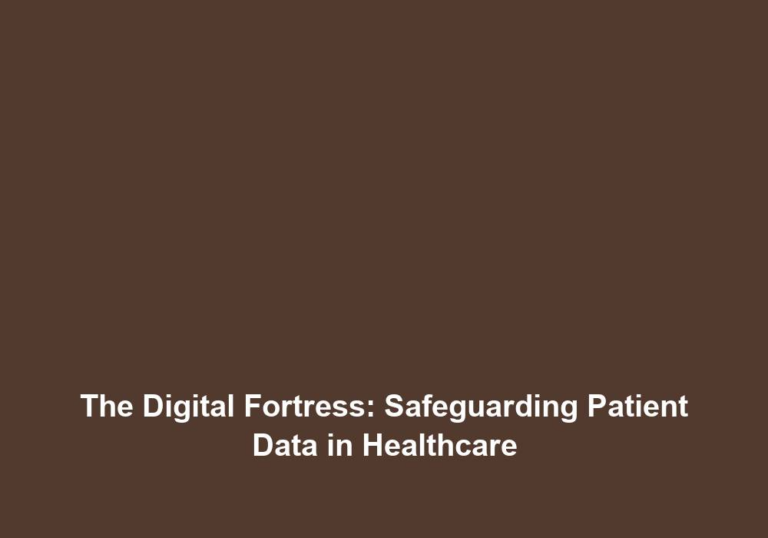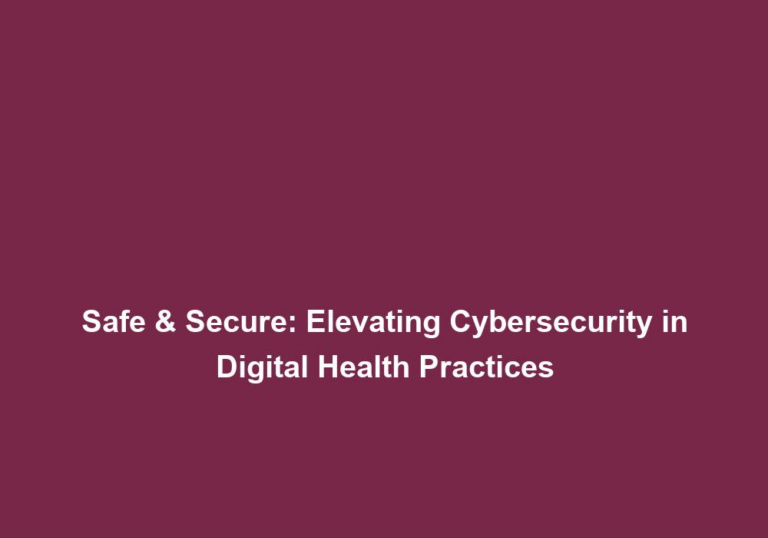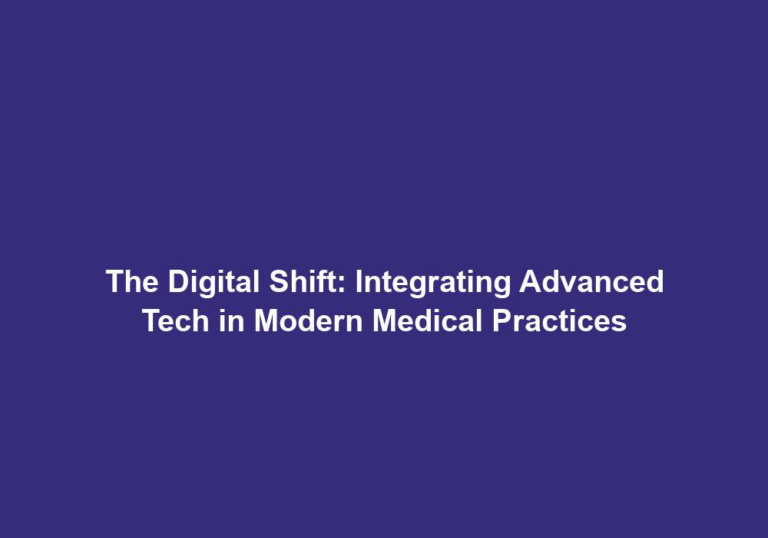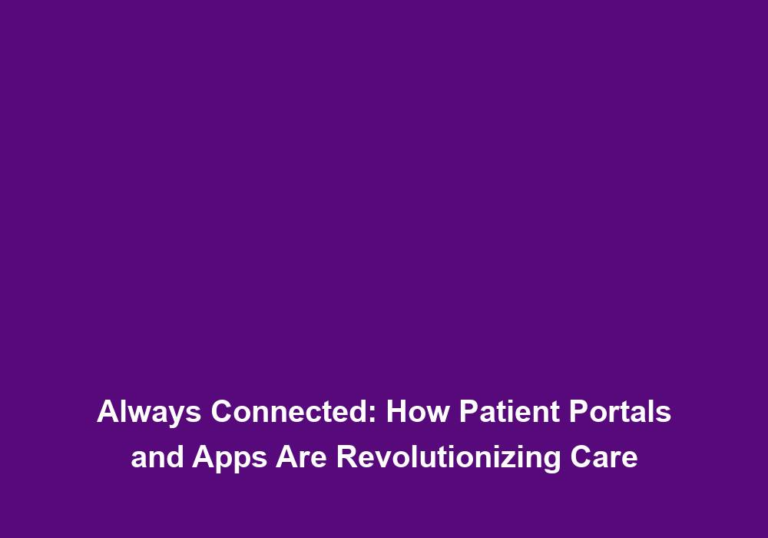Engaging the e-Patient: Leveraging Technology for Better Patient Engagement
In today’s digital age, technology has revolutionized various industries, and the healthcare sector is no exception. With the rise of electronic health records (EHRs), telemedicine, and mobile health applications, the concept of the e-Patient, or electronically engaged patient, has emerged. Engaging e-Patients through technology can significantly improve patient outcomes, increase satisfaction, and enhance overall healthcare delivery. This article explores how healthcare providers can leverage technology to better engage e-Patients.
The Benefits of Engaging e-Patients
Engaging e-Patients is a proactive approach that empowers patients to take an active role in their healthcare journey. By leveraging technology, healthcare providers can offer several benefits to both the patients and the healthcare system as a whole:
- Greater access to information: Technology allows e-Patients to access a wealth of health-related information at their fingertips. They can read about their condition, treatment options, and preventive measures, enabling them to make informed decisions about their healthcare.
- With the abundance of online resources and medical websites, e-Patients can research their conditions, symptoms, and treatment options to gain a comprehensive understanding. This access to information empowers patients to actively participate in their healthcare decisions, leading to improved outcomes.
- Online patient communities and forums provide a platform for e-Patients to connect with others who have similar conditions, allowing them to share experiences, learn from each other, and find support.
- Enhanced communication: Technology enables seamless communication between healthcare providers and e-Patients. Through secure messaging platforms, patients can ask questions, seek clarifications, and receive updates from their healthcare team, fostering a stronger patient-provider relationship.
- Secure messaging platforms provide a convenient and efficient way for e-Patients to communicate with their healthcare providers. Patients can discuss their concerns, ask follow-up questions, and receive timely responses, eliminating the need for unnecessary office visits.
- Virtual consultations via video calls or teleconferences allow e-Patients to have face-to-face interactions with their healthcare providers without the need for in-person appointments. This is especially beneficial for patients who live in remote areas or have limited mobility.
- Improved coordination of care: By leveraging technology, healthcare providers can streamline the coordination of care among different specialists, ensuring that e-Patients receive comprehensive and well-coordinated healthcare services. This reduces the risk of errors, duplication of tests, and improves the overall patient experience.
- Electronic health records (EHRs) allow healthcare providers to access a patient’s complete medical history, including diagnoses, medications, allergies, and test results. This comprehensive view of the patient’s health enables better coordination and collaboration among healthcare professionals involved in the patient’s care.
- Telemedicine platforms facilitate the sharing of patient information and medical records between healthcare providers, ensuring that all involved parties have access to the same information. This enables better coordination and continuity of care, leading to improved patient outcomes.
- Increased patient satisfaction: Engaging e-Patients through technology provides a convenient and efficient healthcare experience. Patients can schedule appointments online, access their medical records electronically, and receive telemedicine consultations, eliminating the need for unnecessary travel. This convenience leads to higher patient satisfaction and better patient retention rates.
- Online appointment scheduling systems allow e-Patients to book appointments at their convenience, without the need to wait on hold or navigate complex phone systems. This reduces the time and effort required to schedule appointments, improving patient satisfaction.
- Electronic access to medical records eliminates the need for patients to carry physical copies of their records or rely on healthcare providers to send them. This not only improves convenience but also ensures that healthcare providers have access to the most up-to-date information, leading to more effective and efficient care.
- Empowerment and self-management: Technology equips e-Patients with tools and resources to actively manage their health. From fitness trackers to mobile applications for tracking medications and symptoms, e-Patients can take control of their health and well-being, leading to better health outcomes.
- Fitness trackers and wearable devices enable e-Patients to monitor their physical activity, sleep patterns, and vital signs. This data can be shared with healthcare providers, allowing for personalized recommendations and interventions to improve overall health.
- Mobile applications for medication tracking and symptom monitoring help e-Patients adhere to their treatment plans and recognize patterns or triggers related to their condition. This empowers patients to make informed decisions and take necessary actions to manage their health effectively.
Leveraging Technology for e-Patient Engagement
Engaging e-Patients effectively requires the strategic utilization of various technological tools and platforms. Here are some key approaches that healthcare providers can adopt:
1. Electronic Health Records (EHRs)
EHRs serve as a central repository for a patient’s medical information, providing a comprehensive view of their health history. Healthcare providers can leverage EHRs to engage e-Patients by:
-
Granting patients access to their EHRs, allowing them to review their medical history, test results, and immunization records.
-
Allowing patients to update their personal information, allergies, and medication lists, ensuring accurate records.
-
Enabling secure messaging through the EHR system, facilitating communication between patients and healthcare providers.
-
Giving patients access to their EHRs puts them in control of their health information, empowering them to actively participate in their care. Patients can review their medical history, track their progress, and identify areas for improvement.
-
Secure messaging through the EHR system provides a secure and convenient channel for patients to communicate with their healthcare providers. Patients can ask questions, request prescription refills, or share updates about their condition, promoting ongoing engagement and collaboration.
2. Telemedicine
Telemedicine allows healthcare providers to deliver remote healthcare services to patients, eliminating the need for in-person visits. By integrating telemedicine into their practice, healthcare providers can:
-
Offer virtual consultations, enabling e-Patients to connect with their healthcare providers from the comfort of their homes.
-
Provide follow-up care and monitoring for chronic conditions through telemedicine platforms, reducing the need for frequent in-person visits.
-
Extend healthcare services to underserved areas or patients with limited mobility, ensuring equitable access to care.
-
Virtual consultations provide a convenient option for e-Patients who have difficulty traveling to healthcare facilities or who prefer the convenience of remote consultations. This eliminates geographical barriers and improves access to specialized care.
-
Telemedicine platforms equipped with remote monitoring capabilities enable healthcare providers to remotely track and manage chronic conditions. Patients can transmit data such as blood glucose levels or blood pressure readings to their healthcare providers, allowing for timely interventions and adjustments to treatment plans.
3. Mobile Health Applications
Mobile health applications, or mHealth apps, have gained popularity in recent years. These apps offer a range of features that engage and empower e-Patients, such as:
-
Medication reminders and tracking tools, helping patients adhere to their prescribed treatments.
-
Symptom trackers and health diaries, allowing patients to monitor their symptoms and share data with their healthcare providers.
-
Fitness and wellness apps, promoting healthy lifestyle choices and encouraging patients to actively participate in their well-being.
-
Medication reminder apps help e-Patients stay on track with their medication schedules, reducing the risk of missed doses or incorrect administration. These apps can send notifications, provide dosage instructions, and even facilitate prescription refills.
-
Symptom trackers and health diaries enable e-Patients to monitor their symptoms, triggers, and patterns over time. This data can be shared with healthcare providers, facilitating more accurate diagnoses and personalized treatment plans.
-
Fitness and wellness apps offer exercise routines, diet plans, and health tips to promote healthy habits. These apps can track physical activity, monitor nutrition, and provide insights or recommendations for improving overall well-being.
4. Patient Portals
Patient portals are secure online platforms that provide e-Patients with access to their healthcare information and services. Healthcare providers can leverage patient portals to:
-
Allow patients to schedule appointments, request prescription refills, and view test results online, reducing administrative burden.
-
Provide educational resources, such as articles and videos, to empower patients with knowledge and promote self-care.
-
Facilitate secure messaging between patients and healthcare providers, ensuring timely communication and addressing patient concerns.
-
Online appointment scheduling through patient portals offers convenience and flexibility for e-Patients. Patients can view available time slots, choose a suitable appointment, and receive confirmation without the need for phone calls or waiting on hold.
-
Educational resources within patient portals empower e-Patients with information about their conditions, treatment options, and preventive measures. Patients can access reliable and up-to-date materials to enhance their understanding and make informed decisions.
-
Secure messaging features allow e-Patients to communicate directly with their healthcare providers, eliminating the need for phone calls or voicemails. Patients can ask questions, report changes in symptoms, or request clarification on treatment plans, fostering ongoing engagement and collaboration.
Best Practices for Engaging e-Patients
To maximize the effectiveness of technology in engaging e-Patients, healthcare providers should consider the following best practices:
-
User-friendly interfaces: Ensure that technology platforms and applications are intuitive and user-friendly, catering to patients with varying levels of digital literacy.
-
Design technology interfaces with a user-centric approach, considering the needs and preferences of e-Patients. Use clear and concise language, intuitive navigation, and user-friendly features to enhance usability.
-
Provide user guides, tutorials, or online support resources to assist e-Patients in navigating and using technology tools effectively.
-
Clear communication: Provide clear instructions and guidance on how to access and utilize technology tools to engage e-Patients effectively.
-
Clearly communicate the benefits and purpose of using technology tools to e-Patients, emphasizing how these tools can improve their healthcare experience and outcomes.
-
Provide step-by-step instructions, video tutorials, or user manuals to guide e-Patients in using technology tools. Address common questions or concerns proactively to minimize confusion or frustration.
-
Data security and privacy: Prioritize patient data security and privacy by implementing robust security measures and complying with applicable regulatory guidelines.
-
Implement encryption, secure authentication, and data access controls to protect e-Patient information from unauthorized access or breaches.
-
Adhere to industry standards and regulatory requirements, such as HIPAA (Health Insurance Portability and Accountability Act), to ensure the privacy and confidentiality of e-Patient data.
-
Continuous education and support: Offer ongoing education and support to e-Patients, guiding them on how to use technology tools and empowering them to make the most of available resources.
-
Provide educational materials, webinars, or workshops to educate e-Patients on the benefits and functionalities of technology tools. Address common concerns or misconceptions to build trust and confidence.
-
Establish support channels, such as dedicated helplines or online chat support, to assist e-Patients in troubleshooting issues or answering their questions promptly.
-
Regular feedback and improvement: Seek feedback from e-Patients on their experience with technology-enabled engagement initiatives and use it to continuously improve and enhance the offerings.
-
Conduct surveys, interviews, or focus groups to gather feedback from e-Patients about their experience with technology tools. Identify areas for improvement and implement changes accordingly.
-
Actively listen to e-Patient feedback and suggestions, demonstrating a commitment to their needs and preferences. Engage in open dialogue and transparency to foster a sense of partnership and collaboration.
By embracing technology and adopting patient-centric approaches, healthcare providers can engage e-Patients effectively, leading to improved patient outcomes, enhanced patient satisfaction, and a more efficient healthcare system. The future of healthcare lies in leveraging technology to empower and engage patients in their care journeys, and the time to embrace this shift is now.
Please note that this article has been generated by OpenAI’s GPT-3 language model and reviewed by human editors to ensure fluency in English.







